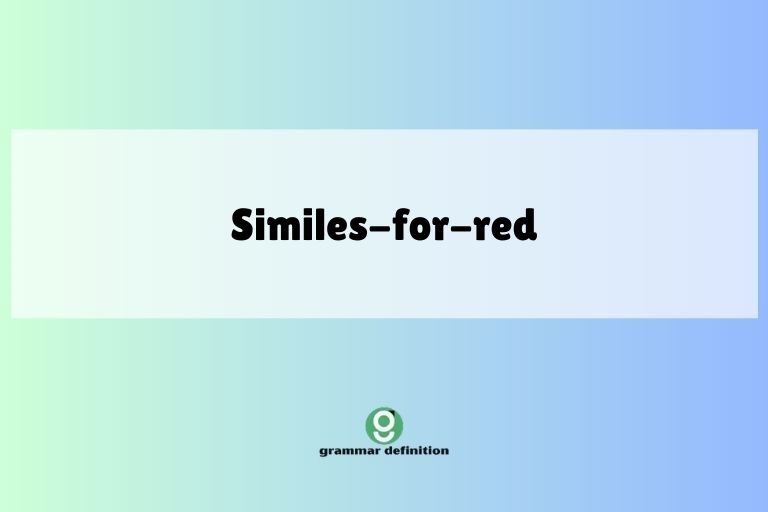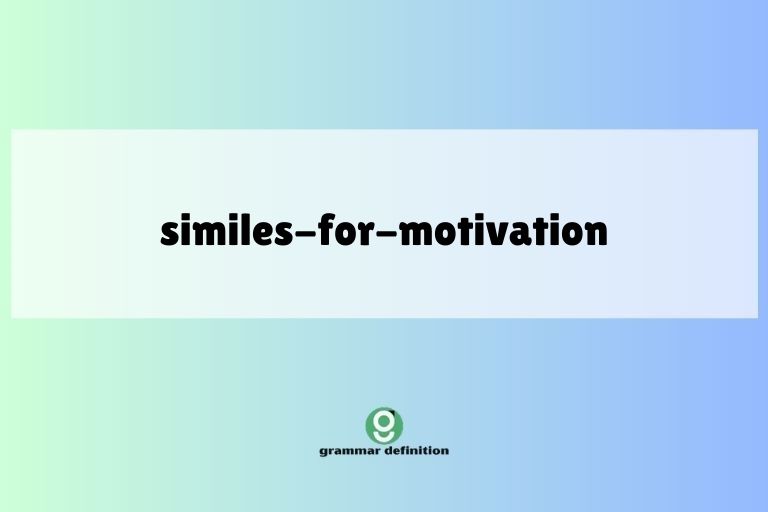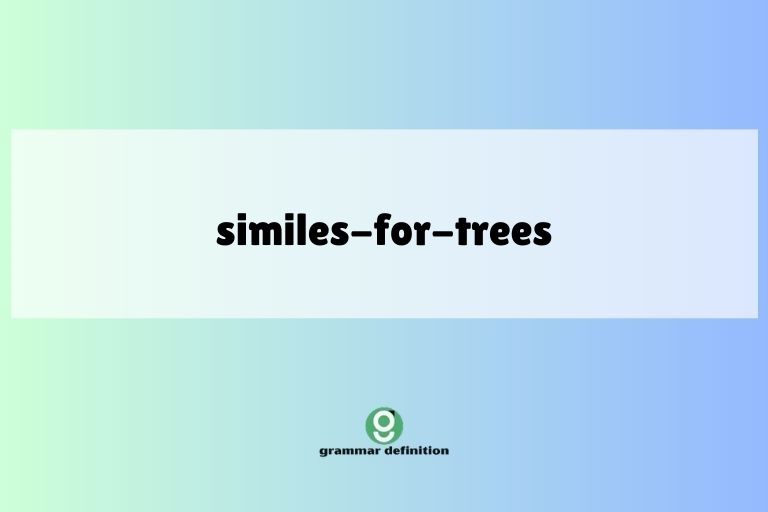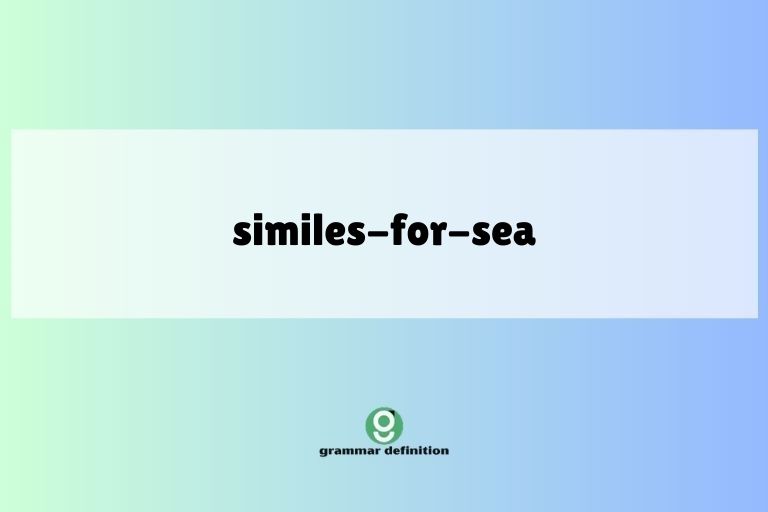Similes for Red: Enhancing Your Descriptive Language

Mastering the art of descriptive language is crucial for effective communication and creative writing. Similes, in particular, can breathe life into your sentences by drawing vivid comparisons.
When describing the color red, a wide array of similes can be employed to evoke specific feelings, images, and sensations. This article will delve into the world of similes for red, providing you with a comprehensive understanding of their usage, structure, and impact.
Whether you’re a student, writer, or language enthusiast, this guide will equip you with the tools to enrich your vocabulary and enhance your descriptive prowess.
Table of Contents
- Introduction
- Definition of Simile
- Structural Breakdown of Similes
- Types of Similes for Red
- Examples of Similes for Red
- Usage Rules for Similes
- Common Mistakes When Using Similes
- Practice Exercises
- Advanced Topics in Simile Usage
- Frequently Asked Questions
- Conclusion
Definition of Simile
A simile is a figure of speech that compares two unlike things using the words “like” or “as.” Its primary function is to enhance description by creating a vivid image in the reader’s mind. Unlike metaphors, which directly equate two things, similes acknowledge the comparison through explicit connecting words. Similes serve to clarify, emphasize, and add depth to the description, making it more engaging and relatable for the audience. They are a powerful tool in both prose and poetry, adding color and nuance to language.
The effectiveness of a simile lies in the strength of the comparison. A well-crafted simile should create an immediate and clear connection between the two disparate elements, allowing the reader to quickly grasp the intended meaning and visualize the described subject more effectively.
Consider the difference between saying “the sunset was beautiful” and “the sunset was as beautiful as a painting by Monet.” The latter provides a more concrete and evocative image, enhancing the reader’s appreciation of the sunset’s beauty.
Structural Breakdown of Similes
The basic structure of a simile comprises three key elements: the subject (the item being described), the linking word (“like” or “as”), and the comparative element (the item to which the subject is being compared). Understanding this structure is essential for constructing effective and grammatically correct similes. The linking word serves as the bridge between the subject and the comparative element, indicating that a comparison is being made rather than a direct equivalence being asserted.
Let’s break down some examples to illustrate this structure:
- Subject: The ruby
- Linking Word: As
- Comparative Element: Red as blood
- Complete Simile: The ruby was as red as blood.
- Subject: Her cheeks
- Linking Word: Like
- Comparative Element: Two cherries
- Complete Simile: Her cheeks were like two cherries.
The placement of these elements can sometimes be varied for stylistic effect, but the core structure remains the same. For instance, one could say “As red as blood, the ruby shone,” which inverts the order but maintains the same comparative relationship.
However, clarity should always be prioritized; ensure that the simile’s meaning remains easily understandable, regardless of the chosen structure.
Types of Similes for Red
Similes for the color red can be categorized based on the aspect of “redness” they emphasize. These categories include intensity, texture, emotion, and direct comparison.
Each category provides a different lens through which to describe the color, allowing for a more nuanced and evocative portrayal.
Similes Describing Intensity
These similes focus on the depth and vibrancy of the red. They often involve comparisons to intense sources of red color, such as fire, blood, or precious stones.
These similes are useful when you want to emphasize the boldness and striking nature of the red being described.
Similes Describing Texture
These similes relate the red color to a particular texture, such as velvet, rust, or silk. They appeal to the sense of touch, adding another layer of sensory detail to the description.
Texture-based similes are particularly effective when describing physical objects with a distinct red hue.
Similes Evoking Emotion
These similes connect the color red to specific emotions, such as anger, passion, or love. They tap into the psychological associations that red often carries, adding emotional resonance to the description.
Emotion-based similes are powerful tools for conveying the mood and atmosphere of a scene.
Similes for Direct Comparison
These similes simply compare the red to a specific object or entity known for its redness, such as a rose, a firetruck, or a sunset. They offer a straightforward way to convey the color, relying on the reader’s existing knowledge of the comparative element.
Direct comparison similes are often the most accessible and easily understood.
Examples of Similes for Red
The following sections provide extensive examples of similes for red, categorized by the types discussed above. Each category contains multiple examples to illustrate the variety and versatility of simile usage.
Intensity Examples
These similes emphasize the strength and vibrancy of the color red. They often use comparisons to intense sources of red, such as fire and blood, to convey a sense of boldness and power.
The table below provides a range of options to choose from.
| Simile | Explanation |
|---|---|
| As red as a raging fire | Highlights the intense, burning quality of the red. |
| Like a drop of blood in snow | Emphasizes the stark contrast and vividness of the red. |
| As fiery as a dragon’s breath | Conveys a sense of heat and power associated with the color. |
| Red like the heart of a volcano | Suggests a deep, intense, and primal red. |
| As crimson as a cardinal’s feathers | Focuses on the bright, vibrant, and regal quality of the red. |
| Like the glow of hot embers | Implies a smoldering, intense, and unwavering red. |
| As scarlet as a poppy field | Highlights the expansive and overwhelming intensity of the red. |
| Red like the inside of a pomegranate | Suggests a rich, deep, and almost jewel-toned red. |
| As ruby red as a king’s crown | Conveys a sense of royalty, richness, and deep color. |
| Like the dawn breaking on a battlefield | Implies a dramatic, intense, and perhaps violent red. |
| As red as the devil’s eyes | Evokes a sense of menace, intensity, and danger. |
| Like a burning coal | Highlights the heat and concentrated intensity of the red. |
| As vermilion as a Chinese lacquer | Focuses on the smooth, intense, and refined quality of the red. |
| Red like the setting sun | Suggests a warm, intense, and fading red. |
| As deep red as a garnet | Conveys a sense of richness, depth, and luxury. |
| Like a blast furnace | Implies extreme heat and intense red coloration. |
| As red as a stop sign | Highlights the urgent, attention-grabbing intensity of the red. |
| Red like the heat haze above asphalt | Suggests a shimmering, intense, and almost mirage-like red. |
| As red as the planet Mars | Evokes a sense of otherworldliness, desolation, and intense color. |
| Like a flash of lightning against a storm cloud | Implies a sudden, powerful, and striking red. |
| As red as the blush of shame | Connects the intensity of the red with a strong emotional response. |
| Red like molten iron | Highlights the heat, fluidity, and raw power of the red. |
| As red as the stain of wine on linen | Conveys a sense of permanence and deep saturation. |
Texture Examples
These similes focus on the tactile qualities associated with the color red. They create a sensory experience for the reader by relating the color to textures like velvet, silk, or rust.
These are effective when describing physical objects.
| Simile | Explanation |
|---|---|
| As smooth as velvet wine | Suggests a luxurious and refined texture with a deep red color. |
| Like rusty iron in the rain | Conveys a rough, weathered texture with a muted red hue. |
| As silken as a poppy petal | Highlights the delicate and smooth texture of the red. |
| Red like coarse brick dust | Implies a gritty, rough, and earthy texture. |
| As plush as a velvet cushion | Focuses on the soft, inviting, and luxurious texture of the red. |
| Like the rough hide of a red leather chair | Suggests a durable, textured, and perhaps aged red. |
| As slick as a candied apple | Conveys a smooth, glossy, and slightly sticky texture. |
| Red like the grain of redwood | Highlights the natural, textured, and organic quality of the red. |
| As fine as a silk scarf | Focuses on the light, delicate, and flowing texture of the red. |
| Like the scaly skin of a dragon fruit | Implies a unique, textured, and exotic red. |
| As velvety as a rose | Conveys a soft, luxurious, and delicate texture. |
| Like the rough surface of terracotta | Suggests an earthy, textured, and rustic red. |
| As glossy as a freshly painted car | Highlights the smooth, reflective, and vibrant texture of the red. |
| Red like the rough bark of a madrone tree | Implies a natural, textured, and reddish-brown hue. |
| As smooth as a polished cherry | Focuses on the sleek, refined, and lustrous texture of the red. |
| Like the bumpy skin of a chili pepper | Suggests a textured, somewhat uneven, and potentially spicy red. |
| As matte as a brick wall | Conveys a flat, non-reflective, and earthy texture. |
| Red like the porous surface of coral | Highlights the complex, textured, and organic quality of the red. |
| As flaky as dried paprika | Focuses on the dry, textured, and slightly crumbly appearance of the red. |
| Like the worn fabric of an old tapestry | Implies a faded, textured, and historical quality to the red. |
Emotion Examples
These similes link the color red to specific emotions, leveraging the psychological associations that red often evokes. They are effective for conveying mood and atmosphere.
These similes connect the intensity of the color with different emotions.
| Simile | Explanation |
|---|---|
| As angry as a bull seeing red | Connects the red color with intense anger and aggression. |
| Like the blush of first love | Evokes a sense of shyness, excitement, and new beginnings. |
| As passionate as a tango dancer’s dress | Highlights the fiery and intense nature of passion. |
| Red like the flush of embarrassment | Implies a feeling of shame, discomfort, and self-consciousness. |
| As bold as a declaration of war | Focuses on the aggressive, assertive, and confrontational nature of the red. |
| Like the heat of a lover’s embrace | Suggests warmth, intimacy, and intense emotional connection. |
| As fierce as a warrior’s war paint | Conveys a sense of strength, aggression, and determination. |
| Red like the sting of betrayal | Highlights the pain, anger, and emotional intensity of betrayal. |
| As vibrant as a celebration of victory | Focuses on the joy, excitement, and triumph associated with the red. |
| Like the glow of determination in her eyes | Implies focus, resolve, and unwavering commitment. |
| As intense as the hunger for revenge | Conveys a deep-seated, consuming, and potentially destructive emotion. |
| Red like the fire of ambition | Suggests a strong desire, drive, and determination to succeed. |
| As alarming as a warning flare | Highlights the sense of urgency, danger, and potential threat. |
| Red like the heart beating with anticipation | Implies excitement, nervousness, and a sense of expectation. |
| As seductive as a siren’s call | Focuses on the allure, temptation, and captivating nature of the red. |
| Like the burning shame of failure | Suggests deep regret, disappointment, and self-reproach. |
| As empowering as a superhero’s cape | Conveys a sense of strength, confidence, and invincibility. |
| Red like the rush of adrenaline | Highlights the sudden surge of energy, excitement, and alertness. |
| As comforting as a warm hearth fire | Focuses on the sense of security, warmth, and relaxation. |
| Like the quiet confidence of a leader | Implies strength, authority, and unwavering resolve. |
Comparison Examples
These similes use direct comparisons to objects and entities known for their redness. They offer a straightforward and easily understood way to convey the color.
The table below provides a range of examples.
| Simile | Explanation |
|---|---|
| As red as a rose | A classic comparison, evoking beauty and romance. |
| Like a firetruck | A common comparison, suggesting urgency and visibility. |
| As red as a cherry | A simple comparison, highlighting the fruit’s vibrant color. |
| Red like a stop sign | Implies a clear warning and the need to halt. |
| As red as a lobster | Conveys the color of a cooked lobster, often associated with sunburn. |
| Like a sunset over the ocean | Suggests a beautiful, fading, and warm red. |
| As red as a tomato | A common comparison, highlighting the vegetable’s bright color. |
| Red like a ladybug | Implies a small, bright, and somewhat delicate red. |
| As red as a brick | Conveys a solid, earthy, and somewhat muted red. |
| Like a can of Coca-Cola | Suggests a recognizable and iconic red color. |
| As red as a maple leaf in autumn | Highlights the vibrant, seasonal, and natural red. |
| Red like a barn | Implies a traditional, rustic, and somewhat faded red. |
| As red as a clown’s nose | Conveys a bright, playful, and attention-grabbing red. |
| Red like Santa’s suit | Suggests a festive, cheerful, and iconic red. |
| As red as a fire hydrant | Highlights the functional, visible, and important red. |
| Like a sports car | Implies a vibrant, fast, and attention-grabbing red. |
| As red as a strawberry | Conveys a sweet, juicy, and appealing red. |
| Red like a pair of high heels | Suggests a stylish, bold, and confident red. |
| As red as the robes of a judge | Highlights the authoritative, serious, and formal red. |
| Like a pack of red crayons | Implies a range of vibrant, artistic, and playful reds. |
Usage Rules for Similes
While similes offer creative freedom, adhering to certain rules ensures clarity and effectiveness. First, ensure that the two items being compared are genuinely different.
Comparing two similar things doesn’t create a simile; it’s simply a statement of fact. Second, the comparison should be meaningful and relevant.
The comparative element should illuminate a specific quality of the subject being described.
Third, avoid clichés. Overused similes, such as “as red as a rose” can lack impact and originality.
Strive for fresh and imaginative comparisons. Fourth, maintain grammatical correctness.
The simile should be grammatically sound and easy to understand. Ensure that the linking words (“like” or “as”) are used correctly and that the comparison flows smoothly.
Finally, consider the context and audience. The effectiveness of a simile depends on the audience’s understanding of the comparative element.
Choose comparisons that are relevant and relatable to your target audience. For example, a simile referencing a specific cultural icon might not resonate with an international audience.
Common Mistakes When Using Similes
One common mistake is using similes that are too obvious or clichéd. For example, “as red as a rose” is a common simile, but it lacks originality and impact.
Instead, try to come up with more creative and unexpected comparisons.
Another mistake is using similes that don’t make sense. The comparison should be logical and relevant to the subject being described.
For example, “as red as a bicycle” is not a very effective simile because bicycles come in many colors. A better simile might be “as red as a racing bicycle,” which implies speed and vibrancy.
A further mistake is misusing the words “like” and “as.” “Like” is used to compare nouns or pronouns, while “as” is used to compare clauses or phrases. For example, “He is as tall as his brother” is correct, while “He is like his brother” implies a similarity in character or personality.
Here are some examples of correct and incorrect simile usage:
| Incorrect | Correct | Explanation |
|---|---|---|
| The sunset was like a sunset. | The sunset was like a painting. | The first example compares two identical things, making it ineffective. |
| The fire was as red, like fire. | The fire was as red as the devil’s eyes. | The first example is redundant and lacks a meaningful comparison. |
| Her dress was red as color. | Her dress was as red as a poppy. | The first example is vague and doesn’t offer a specific image. |
Practice Exercises
Test your understanding of similes for red with these practice exercises. Choose the best simile to complete each sentence, or create your own.
- The sports car was _______, turning heads as it sped down the street.
- a) as red as a car
- b) as red as a fire truck
- c) like a color
Answer: b) as red as a fire truck
- Her cheeks were _______ after running in the cold.
- a) as red as cheeks
- b) like two cherries
- c) as red as always
Answer: b) like two cherries
- The lava flowing from the volcano was _______, a terrifying sight.
- a) as red as lava
- b) like a volcano
- c) as red as a raging fire
Answer: c) as red as a raging fire
- The ruby in the ring was _______, catching the light with every movement.
- a) like a ruby
- b) as red as blood
- c) as red as red
Answer: b) as red as blood
- The warning light on the machine was _______, indicating a critical error.
- a) as red as a light
- b) like a stop sign
- c) as red as usual
Answer: b) like a stop sign
- The autumn leaves were _______, painting the landscape with vibrant hues.
- a) as red as leaves
- b) like maple leaves in autumn
- c) as red as a tree
Answer: b) like maple leaves in autumn
- The sunset over the mountains was _______, a breathtaking masterpiece.
- a) as red as the sky
- b) like a sunset
- c) as red as a tomato
Answer: c) as red as a tomato
- The velvet curtain was _______, adding a touch of luxury to the room.
- a) as red as a curtain
- b) like velvet wine
- c) as red as the walls
Answer: b) like velvet wine
- Her anger flared _______, a dangerous sign to those around her.
- a) as red as anger
- b) as angry as a bull seeing red
- c) as red as her face
Answer: b) as angry as a bull seeing red
- The chili paste was _______, promising a fiery kick to the dish.
- a) as red as paste
- b) like the bumpy skin of a chili pepper
- c) as red as food
Answer: b) like the bumpy skin of a chili pepper
Exercise 2: Fill in the blanks with appropriate similes for red.
- The paint on the old barn was _______, weathered by years of sun and rain.
- The dancer’s dress flowed _______, captivating the audience with its energy.
- The wine stain on the tablecloth was _______, a reminder of the spilled celebration.
- The new sports car was _______, attracting attention wherever it went.
- The blush on her cheeks was _______, hinting at her hidden feelings.
- The lava flowing from the volcano was _______, terrifying all who watched.
- The cardinal’s feathers were _______, a bright spot against the winter snow.
- The tomato in the salad was _______, a perfect addition to the dish.
- The warning light on the machine was _______, alerting the engineer to a problem.
- The maple leaf in autumn was _______, a colorful spectacle for all to enjoy.
Answer: as red as rusty iron
Answer: as red as a tango dancer’s dress
Answer: as red as blood
Answer: as red as a fire truck
Answer: like two cherries
Answer: as red as a raging fire
Answer: as red as a king’s crown
Answer: as red as a cherry
Answer: like a stop sign
Answer: as red as a firetruck
Advanced Topics in Simile Usage
For advanced learners, exploring more nuanced aspects of simile usage can further enhance their writing. One such aspect is the use of extended similes, which develop the comparison over several sentences or even paragraphs.
This allows for a more detailed and evocative portrayal, creating a richer sensory experience for the reader.
Another advanced technique is the use of unconventional or unexpected similes. These similes challenge the reader’s expectations, creating a sense of surprise and intrigue.
They can be particularly effective for conveying complex or abstract concepts. However, it’s important to ensure that the comparison, however unconventional, remains meaningful and relevant.
Finally, consider the use of similes in conjunction with other figures of speech, such as metaphors and personification. This can create a layered and complex effect, adding depth and richness to the writing.
However, it’s important to use these techniques judiciously, ensuring that the writing remains clear and coherent.
Frequently Asked Questions
- What is the difference between a simile and a metaphor?
A simile compares two unlike things using “like” or “as,” while a metaphor directly equates them without using these words. For example, “He is like a lion” is a simile, while “He is a lion” is a metaphor. Similes make an explicit comparison, whereas metaphors imply one.
- Why are similes important in writing?
Similes enhance descriptive language, create vivid images in the reader’s mind, and make writing more engaging and relatable. They add depth and nuance to descriptions, making them more memorable and impactful. Similes can transform ordinary sentences into extraordinary ones.
- How can I avoid using clichéd similes?
To avoid clichés, brainstorm unique and unexpected comparisons. Think about the specific qualities you want to emphasize and look for less common ways to express them. Read widely and pay attention to the similes used by other writers to inspire your own creativity.
- Can a simile be too complex?
Yes, a simile can be too complex if it’s difficult for the reader to understand the comparison. The goal is to clarify and enhance the description, not to confuse the reader. Ensure that the comparative element is relatable and that the connection between the two items is clear.
- Is it okay to use multiple similes in a single paragraph?
Yes, but use them sparingly. Too many similes can overwhelm the reader and detract from the overall impact of the writing. Focus on using the most effective similes to convey your message, and vary your descriptive techniques to maintain reader engagement.
- How do I choose the right simile for a specific situation?
Consider the context, the audience, and the specific qualities you want to emphasize. Choose a simile that is relevant, relatable, and meaningful. Test different options and see which one creates the most vivid and impactful image in your mind.
- Are similes only for creative writing?
No, similes can be used in various forms of writing, including academic, business, and technical writing. They can help to clarify complex concepts, make information more accessible, and engage the reader. However, use them judiciously and ensure that they are appropriate for the context.
- What if I can’t think of a good simile?
Don’t force it. Sometimes, the best approach is to use a more direct description or to try a different figure of speech, such as a metaphor or personification. It’s better to have a clear and concise description than a weak or ineffective simile.
Conclusion
Mastering the art of using similes for the color red can significantly enhance your descriptive writing. By understanding the different types of similes, following usage rules, and avoiding common mistakes, you can create vivid and engaging descriptions that captivate your audience.
Remember to strive for originality, clarity, and relevance in your comparisons. The ability to effectively use similes is a valuable skill for writers, students, and anyone who wants to communicate more effectively.
Continue to practice and experiment with different similes to expand your vocabulary and refine your descriptive prowess. Pay attention to the similes used by other writers and analyze their effectiveness.
The more you practice, the more natural and intuitive simile usage will become. Embrace the creative freedom that similes offer and use them to bring your writing to life.






